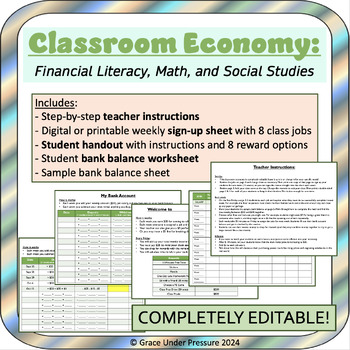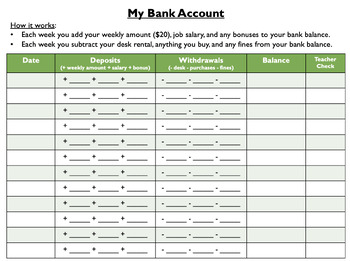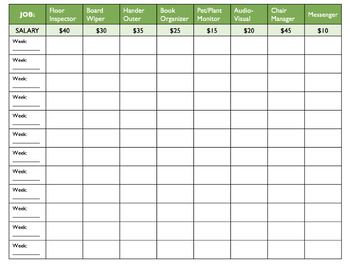Classroom Economy: Grades 4-7 Financial Literacy, Class Jobs, and Rewards
- PPTX
Description
Do you want to teach your middle grades students in grades 4-7 about simple economics? Do you want help around the classroom with chores such as tidying up and putting away chairs? Then implement this super simple class economy routine and teach your students about basic financial literacy, banking, and economics!
What's Included: 6 Pages in an EDITABLE Powerpoint
- Step-by-step teacher instructions for this simple class routine: once started, it should take only 20 minutes every week!
- Digital or printable weekly sign-up sheet with 8 class jobs
- Student handout with instructions and 8 reward options
- Student bank balance worksheet
- Sample bank balance sheet: show your class and practice adding up deposits and withdrawals
Teacher Instructions:
Set-Up:
• This classroom economy is completely editable: leave it as it is or change it for your specific needs!
• Review the jobs on page 3 and change them as necessary. Then print one copy of that page to sign up your students for one term.
• Review page 4. Add your class name at the top. Change the rewards to suit your class. Then print a double-sided page 4 & 5 for each of your students to keep in their binders.
Each week:
• On the first Friday, give your students the handout and assign 2-3 students to each job.
• Show your students the sample bank balance on page 6. Walk through how to complete the math and find the two missing balances ($20 and $30) together.
• Discuss what fines and bonuses you might use.
• Each week, take 20 minutes on Friday to assign the jobs for next week. Students fill out their bank account balance and get it checked by the teacher.
•Students can use their excess money to shop for rewards (and they may combine money together to get a large reward like a class movie).
Inflation:
• If you want to teach your students an extra lesson, incorporate some inflation into your economy.
• After 8-10 weeks, let your students know that the desk rental price is increasing to $35.
• Add $5 to each job salary.
• Talk about how this will decrease their purchasing power, much like rising prices and stagnating salaries do in the real world.
Grades to Use With:
This classroom economy is specifically designed for students in the middle grades (4-7). It can also be a great tool to introduce integers in the 6th grade!





